Introduction
According to the US Agency for Healthcare Research and Quality, quality improvement (QI) is “doing the right thing, at the right time, in the right way, for the right person—and having the best possible results” (as cited in Fesseha & Mathioudakis, 2018).
What does this QI plan aim to achieve:
- Improved outcomes for diabetes patients
- Enhanced staff performance and engagement
- QI targets hospital’ routine activities
This hospital facility has faced some complaints and areas of improvement when the quality of care provided to people with diabetes was reviewed by its management. Quality improvement can be described as performing the right actions at a necessary time for the patient, as defined by the US Agency for Healthcare Research and Quality (as cited in Fesseha & Mathioudakis, 2018). This presentation will detail how this hospital will approach patient X’s condition with this new quality improvement plan considering the five domains of quality.
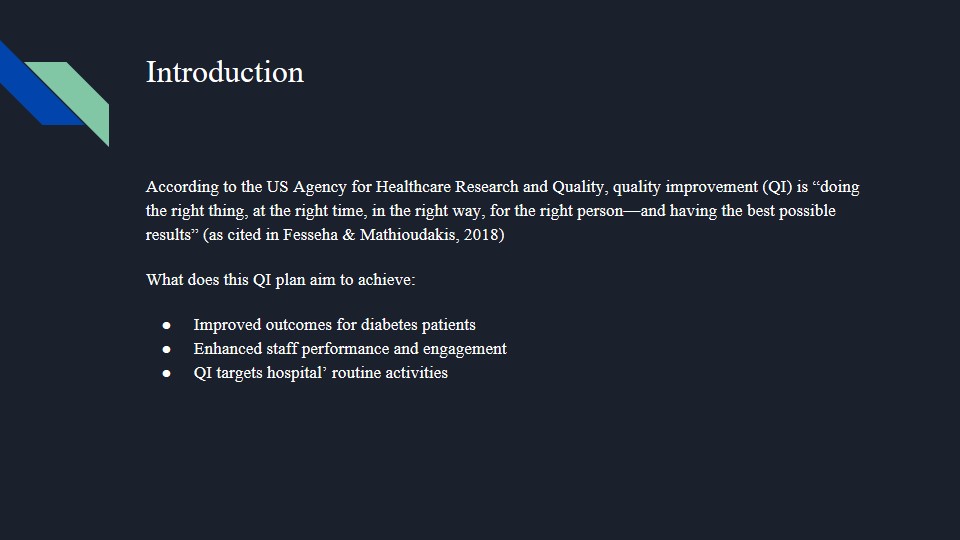
Patient Case
This QI plan is inspired by the following patient case:
- X is a 50 years old woman;
- Emergency department visit;
- Type II diabetes;
- Frequent readmissions;
- Kidney complications.
This QI intervention is based on a patient case of diabetes. Patient X was admitted to this hospital with diabetes. She arrived at the emergency department with the symptoms of emergency hyperglycemia. After being treated with fluid and electrolyte replacement and insulin therapy, X was admitted to the hospital for further evaluations. Her condition was thought to be caused by the patient’s diet, and she was discharged after a short stay.
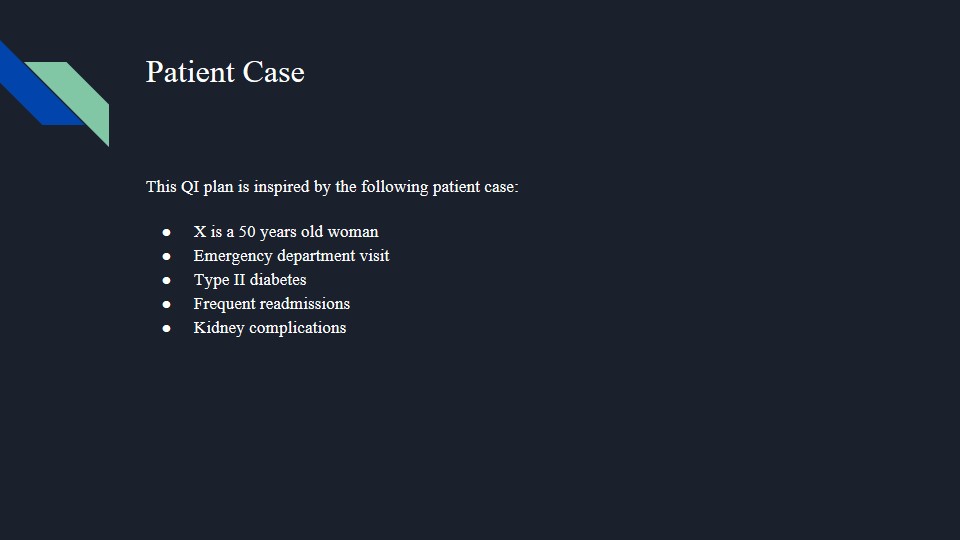
Quality Improvement for Diabetes Care
Diabetes care depends on the following:
- Continuous management;
- Hospital personnel performance;
- Patient’s self-care skills.
This intervention targets:
- Patient education and self-care skills.
Diabetes is a chronic condition, and its management depends not only on the performance of the hospital’s staff but also on the self-management skills of a patient. Particular attention to diet, physical activity, medication, and blood sugar monitoring is necessary to control diabetes successfully. As demonstrated by the case of X, some patients find it challenging to adhere to all recommendations or misunderstand them, which leads to readmissions and complications. According to Fesseha and Mathioudakis (2018), current issues with caring for diabetes are barriers at the levels of the healthcare system, provider, and patient that do not allow individuals to undergo routine screenings and learn how to manage their illness correctly. This QI will target patient education to ensure that individuals admitted to this hospital with diabetes receive sufficient care and knowledge to help them monitor and manage their disease properly.
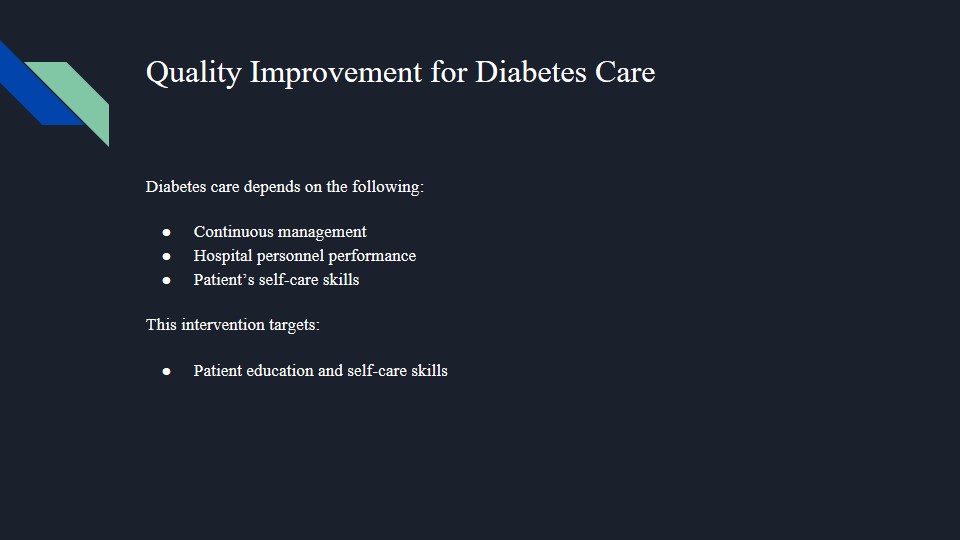
Goals
With this QI, the following hospital-level objectives will be achieved:
- Reduced length of stay for diabetes cases.
- Decreased number of readmissions.
The goals will be delivered by:
- Working with multidisciplinary teams (Fesseha & Mathioudakis, 2018).
- Assessing patients’ feedback.
- Promoting self-care.
This QI will help address the hospital’s diabetes care plan and reduce the length of stay and readmission rates for patients with type I and type II diabetes. This plan will target different aspects of the hospital’s daily routine, for example, one of the steps involves engaging multidisciplinary teams to screen patients and provide advice for further care. This also means allowing pharmacists to have more input into the process of prescribing medication and monitoring its effect (Fesseha & Mathioudakis, 2018). Lastly, targeting individual behavior and self-management is perhaps the most critical element of this QI because it will affect the way diabetes patients manage their condition daily after they are discharged from this hospital.
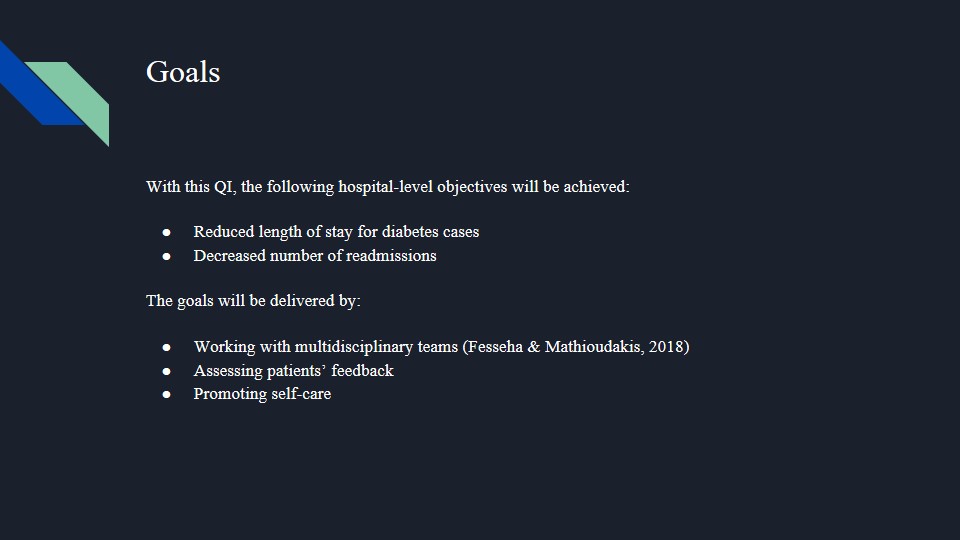
Access
The main issues with access to care:
- The high price of services and medication.
- Increasing costs.
- Patients may avoid treatment.
- This hospital cannot address the overall healthcare flaws in the state.
- Some QI steps will target the local community’s access to care.
- Patient-centered communication.
- Awareness of the cultural differences.
- As noted by Shi (2019), “limited access only postpones the need to deal with a medical problem that inevitably comes back in the form of a complicated medical condition in need of urgent or emergent attention” (p. 23).
The domain of access to care in this QI is a national problem because there are many people who cannot get access to the services of care that they need.
Timely access to care for diabetes patients is essential, both in terms of prevention and to ensure that individuals diagnosed with diabetes do not develop complications.
In the United States, the issue of care access is mainly connected to the costs and insurance payments associated with the provision of healthcare services. High costs, for example, of insulin, can prompt patients to avoid treatments until they develop ketosis and have to be admitted to the emergency department. While this hospital cannot affect the healthcare system in the state, this QI initiative includes some steps that can make it easier for patients with diabetes to receive help, mainly by targeting the local communities.
American Diabetes Association (2016) notes a significant difference in access to healthcare services for people from different social groups and ethnicities. Moreover, the organization’s research shows that some groups of patients are disproportionately devoid of services necessary to care for their diabetes. Some of the steps that this QI offers are: focusing on patient-centered communication when assessing the risk of diabetes, prevention, and treatment. This includes assessing the concerns and paying attention to the socioeconomic barriers that may obstruct the treatment. Next, the personnel of the hospital will participate in an educational workshop, where critical cultural factors and differences, which affect the process of caregiver, will be discussed.
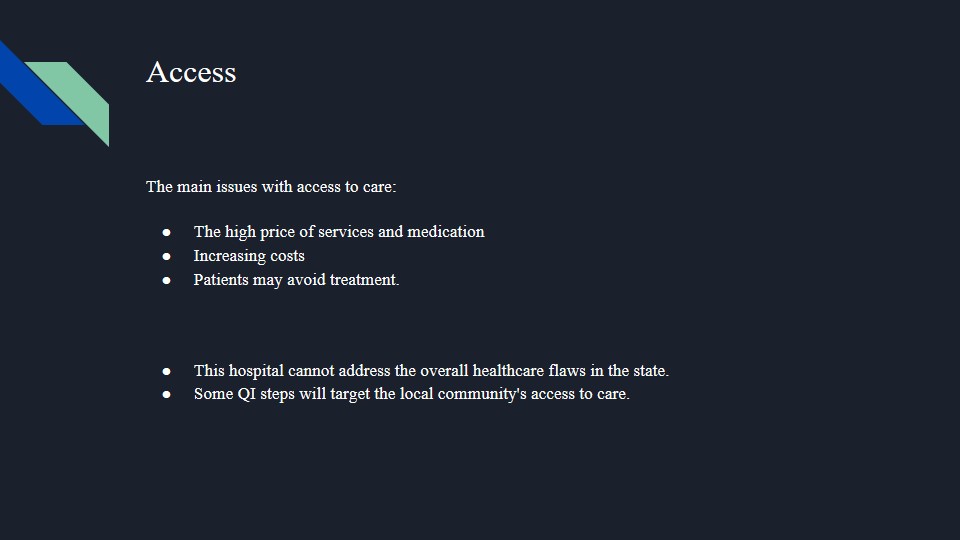
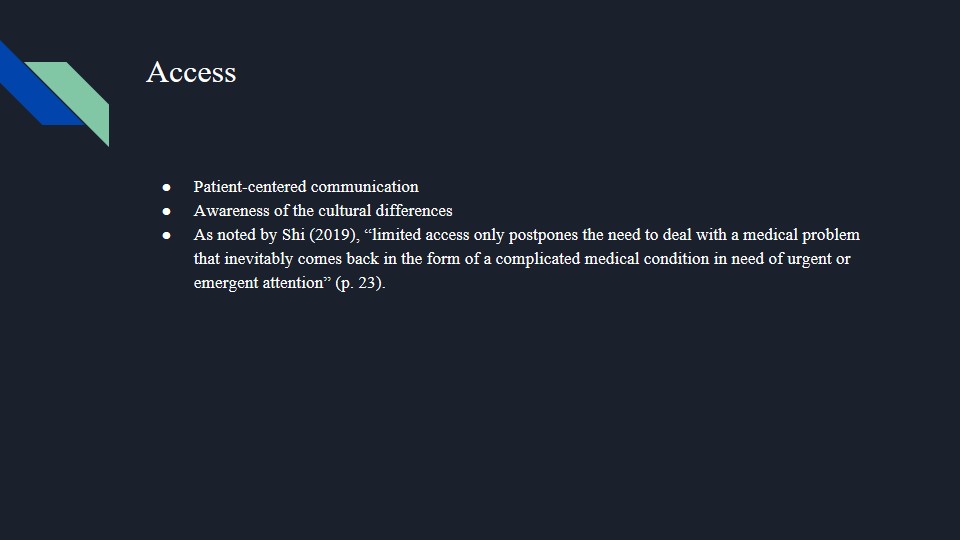
Structure
The hospital’s systems’ improvement:
- Electronic medication ordering.
- Electronic health records.
- Additional training for staff.
- Electronic ordering of medication
- Electronic health records review
- Improving the screening process
- Helping prevent or detect diabetes early
- Enabling early detection of complications
Structure measures relate to the internal processes of a healthcare facility, for example, the use of electronic systems and the number of board-certified physicians (Shi, 2019). In terms of diabetes care, an improvement can be made by implementing a medication entry order system to better track and assess the use of diabetes medication. This system will help address possible issues, such as duplicate orders and tracking the medication. In addition, the application of electronic health records is essential because they allow gathering and reviewing all patient data. In addition, it is vital to ensure that the medical personnel can communicate to patients the importance of proper self-management, which is why additional personnel training should be held.
Electronic medication ordering allows submitting a prescription to a pharmacy directly from the hospital, which should decrease the time necessary to receive the medication. As a result, diabetes patients will benefit since they will be able to gain access to their medication more efficiently. Through the use of digital health records, this hospital will be able to collect all relevant patient data. This is especially important since diabetes often causes serious complications. Moreover, this will help address the QI initiative of yearly screenings for early detection and screening directed at preventing diabetes complications.
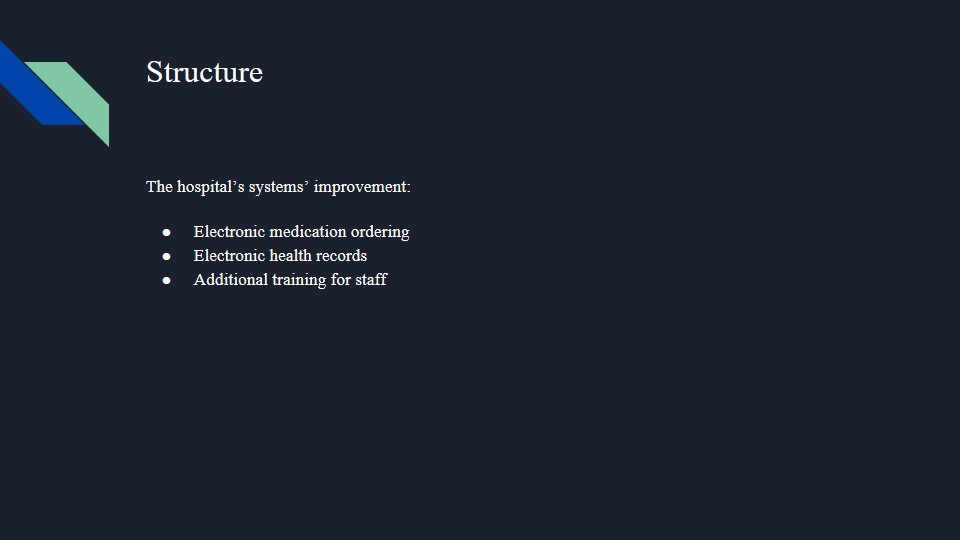
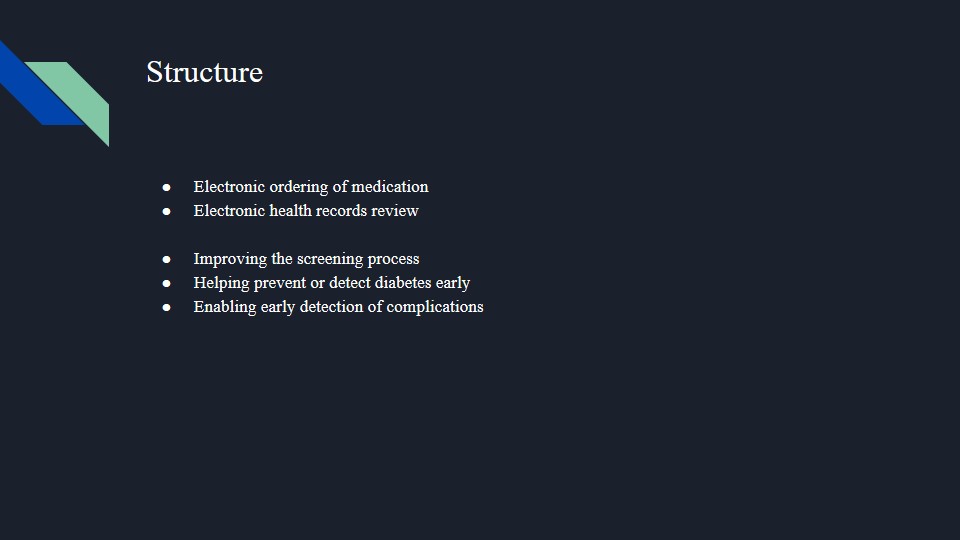
Process
Preventative screenings for diagnosing type II diabetes:
- Blood glucose test;
- Adults over the age of 40;
- Individuals with obesity (Pippitt et al., 2016);
- Testing every three years.
Additional screenings for people with this condition:
- Eye health;
- Kidney failure prevention;
- Cardiovascular diseases;
- Patient education.
Process-related measures should target the provider’s actions to maintain and improve a patient’s health. This can include prevention testing and recurring blood tests or other screenings. The standard health risks for patients with diabetes include “blindness, limb amputation, kidney failure, and vascular and heart disease” (Pippitt et al., 2016, p. 103). The recommendation is to test individuals without diabetes who are over the age of 40 and have obesity by measuring blood glucose levels every three years. This will help detect diabetes early and begin the treatment before permanent organ damage appears. People diagnosed with diabetes should be checked to maintain eye health and prevent kidney damage or cardiovascular diseases.
Screenings for patients with diabetes are necessary because they are at high risk of developing severe complications. Hence, the procedures mentioned above will help prevent cases, such as patient X’s kidney failure.
Additionally, this initiative offers to improve the process of educating patients about their condition and care. This can mean the provision of additional booklets or having a consultation with an advanced practice nurse or physician where the patient will be able to discuss their daily routine and how it should be altered to enable better disease management. Therefore, the process of additional patient education should become routine in this hospital.
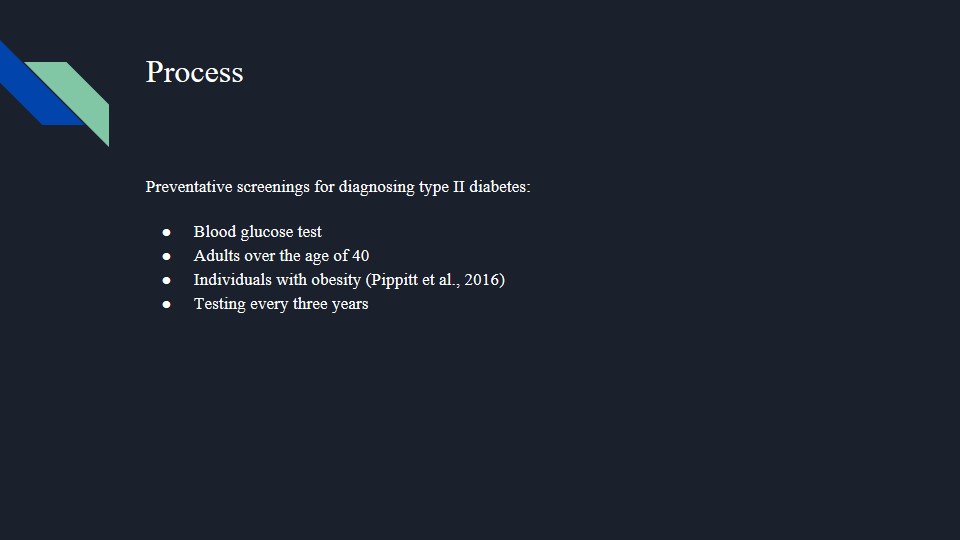
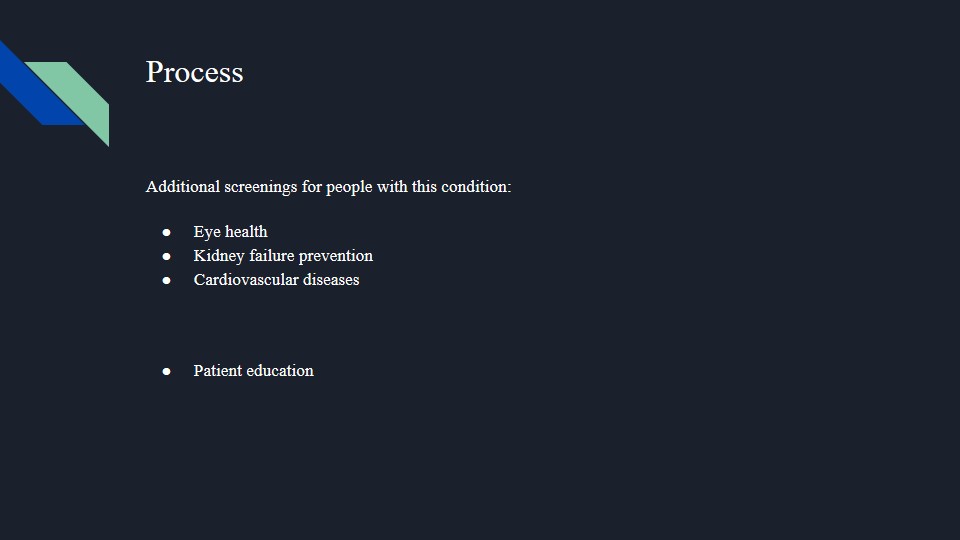
Outcome
- Outcome defines the success of QI initiative.
- Readmission rates within 30 rates help evaluate this domain.
- Current rates range from 14.4% to 22.7% (Ostling et al., 2017).
- The goal is to achieve 15% readmission.
Outcome assessment is perhaps the most critical measure out of the examined in this presentation because it helps assess the end result of the interventions done by this hospital’s personnel. In the case of diabetes, necessary measures include assessing the readmission rates within 30 days. Ostling et al. (2017) state that readmission rates for people with diabetes are much higher than those for other conditions and are estimated at “14.4 and 22.7%,” with the leading cause being an infection (p. 1). The goal of this hospital is to achieve a 15% rate of readmissions through proper screenings and patient education.
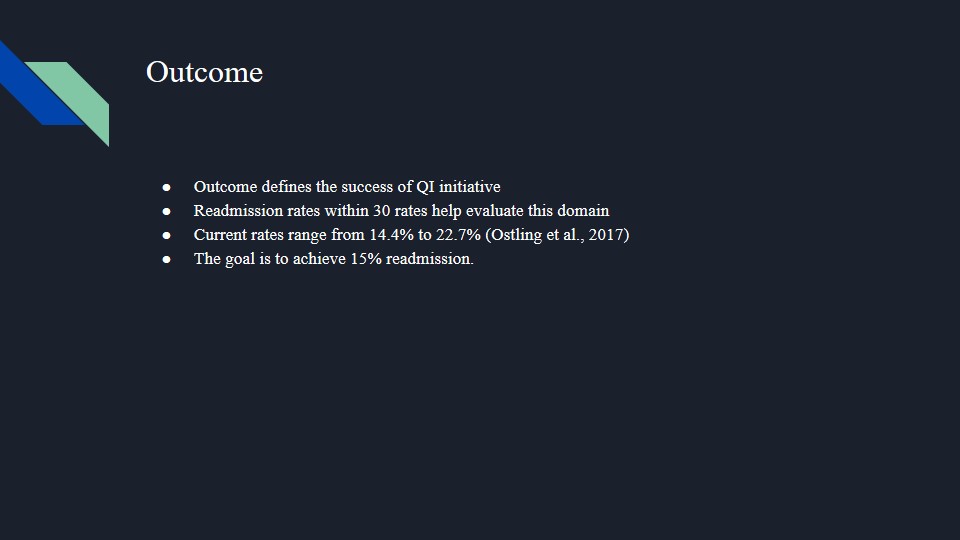
Patient Experience
The current issues with patient experience:
- Poor reporting.
- Inability to detect performance errors.
The solution:
- Improved reporting system.
- Dashboards for diabetes care.
- Benchmarks.
One issue that this QI will address is the prevalence of medical errors with diabetes patients, According to Shi (2019), one of the central flaws of the healthcare system in the United States is the prevalence of medical errors, which arises due to “inadequate performance-reporting procedures” (p. 5). This leads to the inability to track and report errors or other performance problems that can affect patient experience adversely or lead to complications. One way of addressing this is by improving the reporting system and creating dashboards and benchmarks (Shi, 2019). Hence, improved reporting directed at patients with diabetes should help the hospital improve its work.
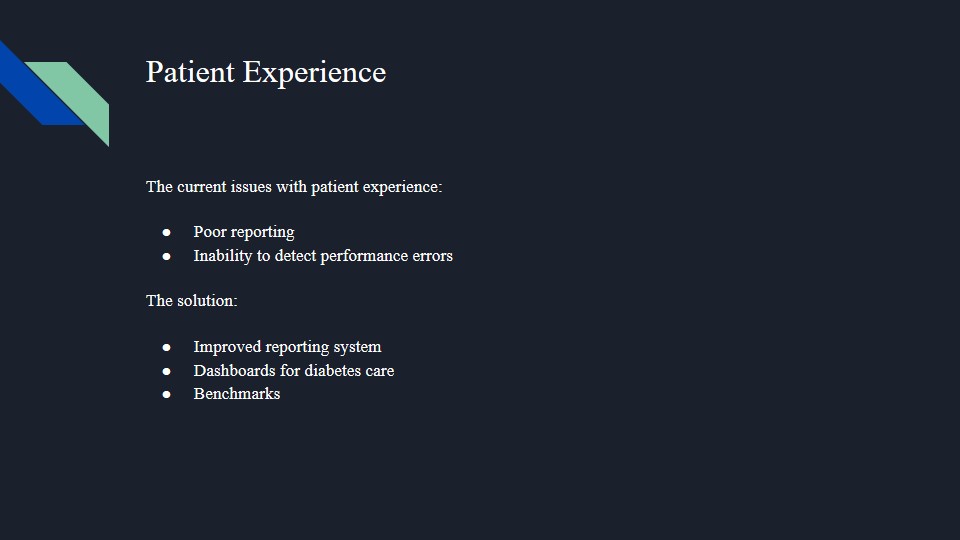
How Will This Be Achieved?
- Plan Do Study Act.
- Developing a plan.
- Implementing the QI strategy.
- Assessing data and feedback.
- Making changes.
- Implementing changes.
- A continuous cycle of improvements.
Any intervention requires changes along the way to adjust the plan accordion to the real-life conditions. The Plan Do Study Act strategy is designed for QI initiatives because it allows one to make changes continuously. As the name of this method suggest, at first, the hospital’s management will develop a plan based on this presentation to outline each step necessary to achieve the desired outcome – decreased readmission and improved self-management. After that, the hospital staff will implement the plan, and the management will use Key Performance Indicators (KPIs) and observation to examine the success of the program. Finally, upon the evaluation, some changes to this plan may be proposed to ensure that the hospital achieves the desired level of quality with diabetes care.
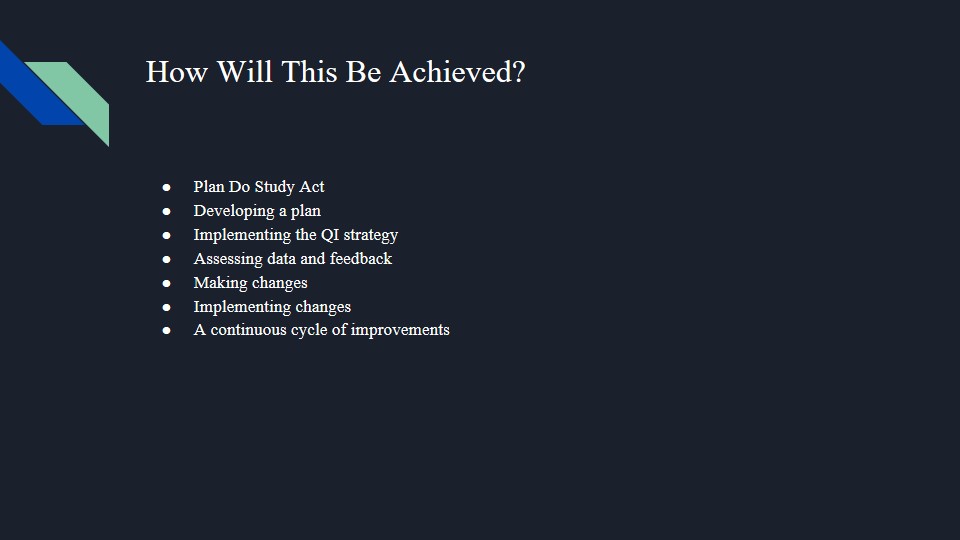
Data Collection
- Data will be collected for the PDSA analysis.
- Patient satisfaction scores.
- Patient feedback on the quality of education.
In order to achieve the goal of improving diabetes care at this hospital, it is essential to not only create a plan to implement it and make changes. It is also necessary to collect data that will help determine whether the efforts of this hospital were successful. The hospital is already obliged to collect some mandatory data, for instance, poor glycemic control or pressure ulcers stage III and IV, this hospital should also collect other data. For example, patient satisfaction scores will help determine if they are satisfied with the sequence of care this hospital offers for them and the performance of medical professionals. In addition to this, the hospital can assess the patient’s feedback on the quality, comprehensiveness, and usefulness of education that will be offered to patients with diabetes.
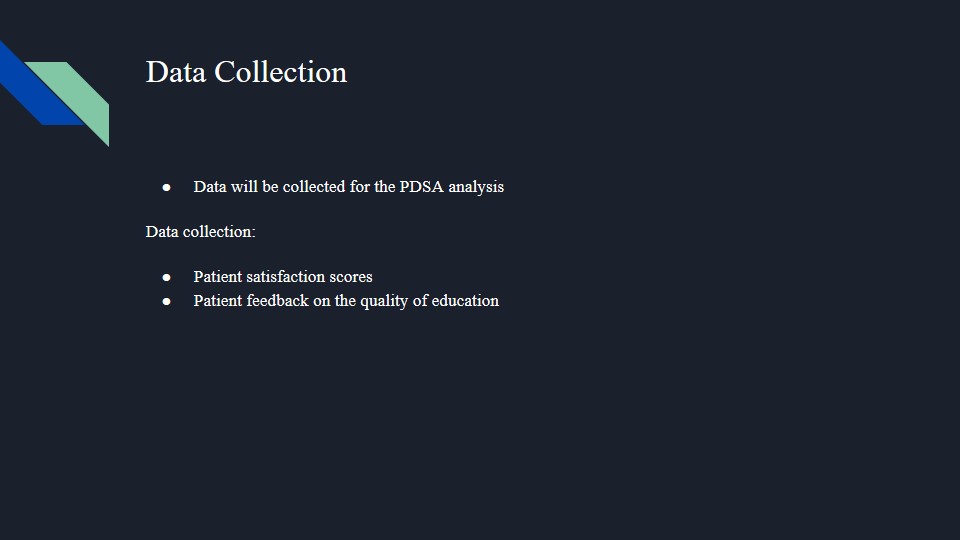
Healthcare Employee Experience
- Structural changes affect the workflow.
- Better efficiency of work.
- A smaller number of diabetes-caused complications.
- Clear targets for performance.
- Increased cultural awareness.
Now let’s discuss how this plan will impact the employees since, although this QI targets patients with diabetes, the procedures and structural changes will affect the hospital’s personnel as well. Although this plan primarily outlines the ways in which patients with diabetes will benefit from the QI initiative, it is essential to note that hospital staff will also experience improvements. The main targets are improved retention, work satisfaction, and engagement that influence the quality of care and attitudes of healthcare employees. Due to the fact that this plan involves a PDSA strategy, development of KPIs, dashboards, data collection, and improvements of patient care, it is anticipated that the changes will improve the work environment for the hospital’s personnel.
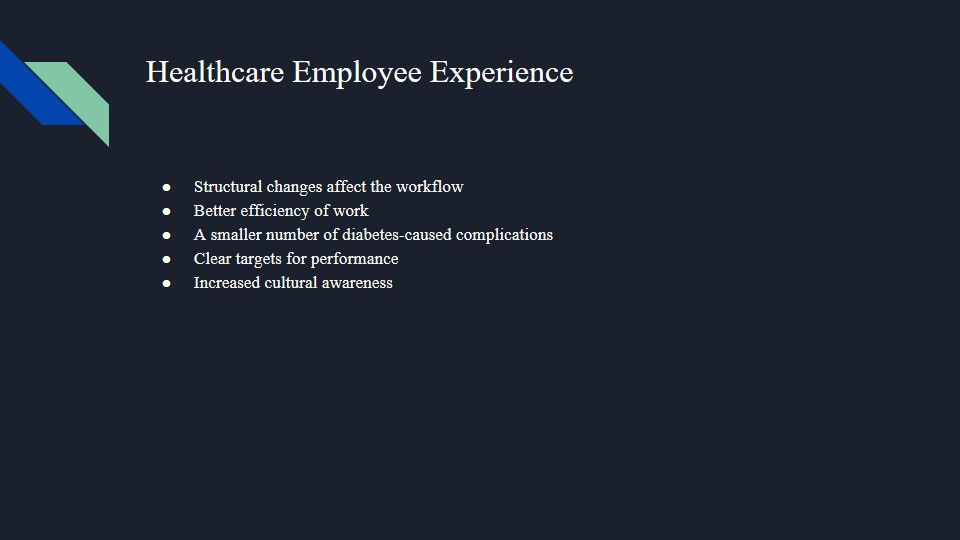
Conclusion
- Patient X was admitted to this hospital with high levels of blood sugar.
- X was readmitted less than 30 days after the discharge.
- X was diagnosed with kidney complications.
- This case prompted to develop a QI strategy that improves the quality of care for diabetes patients.
Overall, this QI initiative was inspired by patient X approached this hospital facility with diabetes Mellitus, and upon discharge was readmitted with severe kidney failure. This prompted the management to rethink the ways in which diabetes is screened and addressed in this hospital. Mainly, apart from prevention measures, this QI initiative aims to improve healthcare education, both for patients and medical professionals.
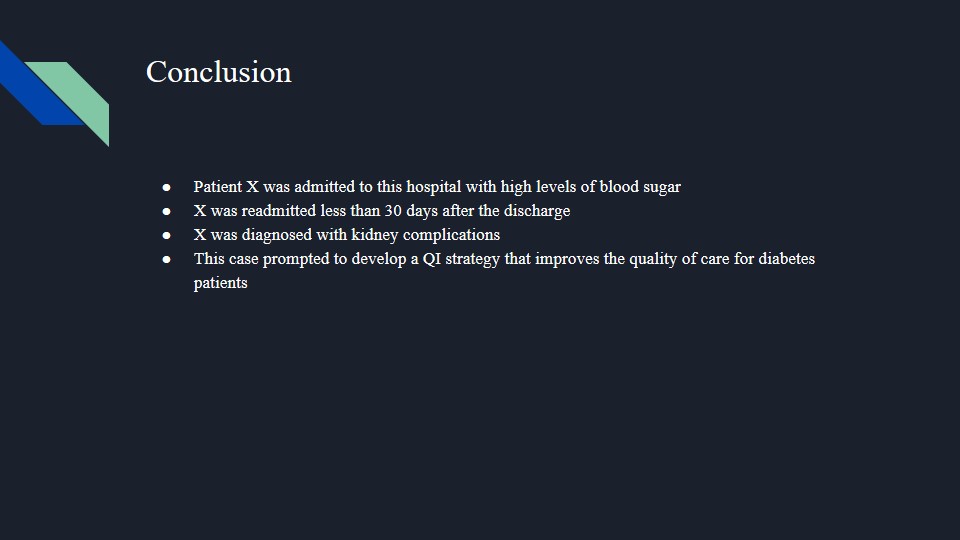
References
American Diabetes Association. (2016). Strategies for improving care. Diabetes Care, 39(1), S6-S12. Web.
Fesseha, B. & Mathioudakis, N. (2018). Quality improvement. John Hopkins. Web.
Ostling, S., Wyckoff, J., Ciarkowski, S., Pai, C., Choe, H., Bahl, V., & Gianchandani, R. (2017). The relationship between diabetes mellitus and 30-day readmission rates. Clinical Diabetes And Endocrinology, 3(1), 1-10. Web.
Pippitt, K., Li, M., & Gurgle, H. (2016). Diabetes mellitus: Screening and diagnosis. American Family Physician, 93(2), 103-109. Web.
Shi, L. (2019). Introduction to healthcare policy (2nd ed.). Health Administration Press.